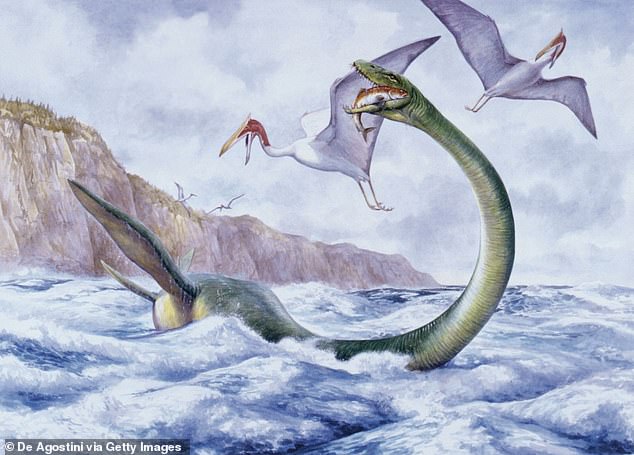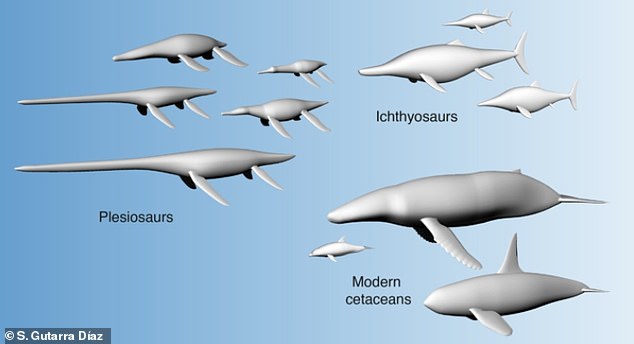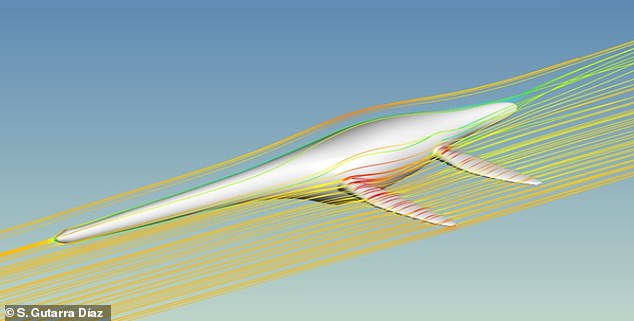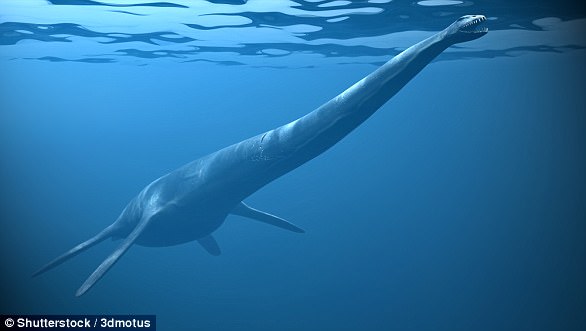Large bodies helped extinct marine reptiles with long necks swim, study finds
Ancient, long-necked sea monsters must have evolved large bodies to rule Earth’s oceans around 200 million years ago, according to a new study.
The large bodies helped the extinct creatures swim at high speeds even though they had bizarre appendages that might otherwise have increased drag and slowed them down.
Bigger bodies meant more muscle mass, and thus allowed them to increase in strength and speed.
This was particularly the case with elasmosaurs, known for their giraffe-shaped neck and a head resembling that of a snake.

Elasmosaurs, known for a giraffe-like neck and snake-like head, is a genus of plesiosaurs that lived in North America during the Campanian stage of the Late Cretaceous, about 80.5 million years ago. years.
The study was conducted by researchers at the University of Bristol, who created various 3D models and performed computer flow simulations to study different extinct tetrapods (four-limbed vertebrates), based on evidence from fossils.
These included ichthyosaurs, a large group of fish-like marine reptiles that first appeared around 250 million years ago and died out before the end of the Cretaceous extinction event (65 million years).
Another group of extinct tetrapods were the plesiosaurs, four-finned marine reptiles with extraordinarily long necks. Plesiosaurs are thought to have appeared in the Late Triassic Period, around 203 million years ago.
Plesiosaurs included elasmosaurs, which had the longest necks of the plesiosaurs.
All extinct creatures have been compared to cetaceans – a modern order of aquatic mammals including whales, dolphins and porpoises.
“We created various 3D models and performed computer simulations of plesiosaur, ichthyosaur and cetacean flows,” said study author Dr Susana Gutarra Díaz from the School of Earth Sciences in Bristol and the National History Museum in London.
“These experiments are done on the computer, but they look like experiments on water tanks.”
the researchers found that big bodies help overcome the excess drag produced by extreme body shapes, such as long necks.

Pictured are 3D models of aquatic tetrapods, including the extinct plesiosaurs and ichthyosaurs
This debunks a long held idea that there is an optimal body shape to ensure low drag in the water.
According to experts, body size is more important than body shape in determining swimming energy saving of aquatic animals.
Another key finding was that the large necks of extinct elasmosaurs added extra drag, but this was offset by the evolution of large bodies.
Although plesiosaurs experienced more drag than ichthyosaurs or whales of equal mass, these differences were relatively minor.
“When we examined a large sample of plesiosaurs modeled on very well-preserved fossils at full size, it turns out that most plesiosaurs had necks below this high drag threshold, within which the neck can lengthen or shorten without increasing drag,” the study said. author Dr Benjamin Moon in Bristol.
“But more interestingly, we showed that extremely long-necked plesiosaurs also developed very large torsos, which compensated for the extra drag.”
For elasmosaurs, long necks were advantageous for hunting, but they could not exploit this adaptation and catch prey until they grew large enough to offset the cost of high drag on their bodies.
“We found that in elasmosaurs, neck proportions changed very rapidly,” said study co-author Dr. Tom Stubbs.
“This study shows that, contrary to mainstream popular knowledge, very long-necked plesiosaurs were not necessarily slower swimmers and whales, and this is partly due to their large bodies.”

Computer simulation of flow on the 3D model of an elasmosaur (elasmosaurs had the longest neck of the plesiosaurs)
However, in the evolutionary quest for swimming speed, body sizes cannot become indefinitely large, as there are also constraints for very large sizes.
“The maximum neck lengths we observe seem to balance the benefits of hunting against the costs of growing and maintaining such a long neck,” said Professor Mike Benton, another co-author.
“In other words, the necks of these extraordinary creatures have evolved in balance with overall body size to minimize friction.”
Until now, the influence of shape and size on swimming energy requirements in these diverse marine animals was unclear, according to the team.
The new study was published today in Communications Biology.
#Large #bodies #helped #extinct #marine #reptiles #long #necks #swim #study #finds







